 JPEG
JPEG
Replies to this thread:
More by JPEG
What people are reading
Subscribers
Please log in to subscribe to JPEG's postings.
:: Subscribe
|
[Please view other pages to see the rest of the postings. Total posts: 238]
|
[VIEWED 391114
TIMES]
|
SAVE! for ease of future access.
|
|
|
|
|
|
JPEG

Please log in to subscribe to JPEG's postings.
Posted on 04-18-09 9:46
AM
Reply
[Subscribe]
|
Login in to Rate this Post:
1  ?
?  Liked by
Liked by
|
| |
Last edited: 11-Jun-09 09:12 AM
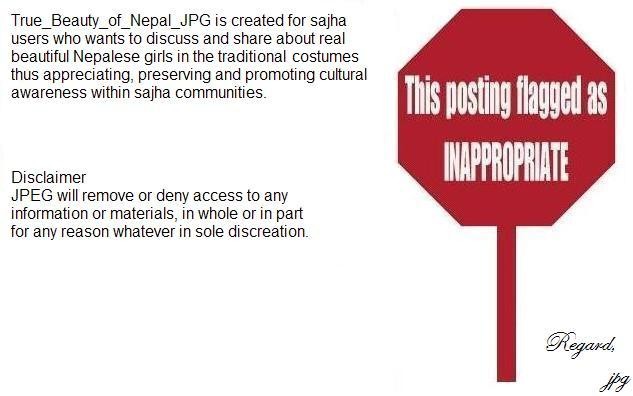
|
| |
|
|
|
|
JPEG

Please log in to subscribe to JPEG's postings.
Posted on 06-10-09 8:37
PM
Reply
[Subscribe]
|
Login in to Rate this Post:
0  ?
? 
|
| |
Newar ni beauty with Dhimay From Wikipedia, Dhimay or Dhimaya (Nepal Bhasa: धिमय्) is a double-headed cylindrical drum with a big wooden or metallic body. It a type of struck drum, technically a membranophone. Newars in Musics: The Newars are very much rich in traditional, classical and folk music as in dances. Various music and dance events take place in different parts of Newar societies on the occasion of different festivals. In fact, the Newars are so duly intermixed with music and dances that not a single festival, feast or ceremony, 'from womb to tomb', passes without a music or music and dances. Various songs, musical instruments and dances are connected with various religious, social and cultural life of the Newars. Different musical instruments are in practice in the festival, feasts, ceremonies and also in funeral procession. Musical instruments: It is believed that there are about 200 (two hundred) types of original musical instruments in Nepal, and 108(one hundred eight types) of musical instruments have been found till now. A great number of Newar musical instruments are included init. These instruments can be classified into four classes according to Sangeet Shastra. i) Membranophones - Dhimay, Dhah, Paschima, NayaKhin etc. ii) Idiophones - Bhusyah, Chhusyah, TainNain etc. iii) Chordophones - Piwancha iv) Aerophones - Muhali, Nekoo, Bansuri etc. Mostly used musical instruments in Newar societies are membranophones, which are generally accompanied with idiophones and aerophones. Membranophones: Dhimay is the most common musical instruments amongst the Newars. It is considered as the oldest musical instruments amongst the membranophones. Even though there is no evidence that Mahadeva invented this instruments (as legend says) but there is evidence to support that it dates back to Kirat period. It resembles the Chyabrung of Kirat Rais and Dhola of Tharus. Dhimay is played in almost all ceremonial marches by the Jyapus. They are fund lost in dancing with deep rumble of Dhimay in festivals. Dhimay is constructed from cylindrical hollowed tree trunk with leather pads at both of its ends. Nowadays, Dhimays are frequently made of brass and other metals. the general size of Dhimay is 20" in length and 16" in diameter .Its left hand hide which sounds much higher is known as Nasah, whilst another hide is called Mankah or Haima. Mankah carries a tunning paste inside. Dhimays are of two kinds: bigger Ma Dhimay and smaller Dhahcha Dhimay or Yalaypoh Dhimay. Dhimay has capacity to produce a multiple reverberating echo, which is its main feature. Dhimay is accompanied with Bhusyah (a pair of cymbals). Chhusyah and TainNain is also played in some places. work reference: http://www.geocities.com/newanepal/musical.html
Last edited: 10-Jun-09 08:40 PM
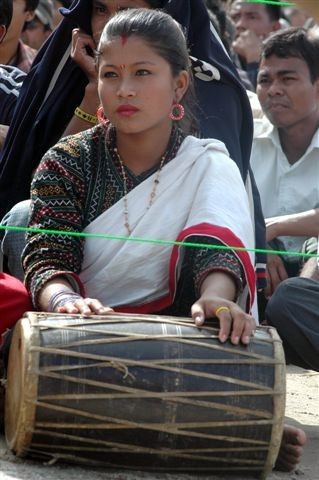
|
| |
|
|
JPEG

Please log in to subscribe to JPEG's postings.
Posted on 06-11-09 9:38
AM
Reply
[Subscribe]
|
Login in to Rate this Post:
0  ?
? 
|
| |
Three Newar ni beauties i managed to take shot of during the Newari new year.

|
| |
|
|
JPEG

Please log in to subscribe to JPEG's postings.
Posted on 06-11-09 10:26
AM
Reply
[Subscribe]
|
Login in to Rate this Post:
0  ?
? 
|
| |
Respect the True_Beauty_of_Nepal “A generation which ignores history has no past and no future.â€
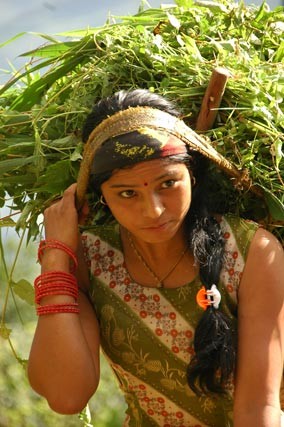
|
| |
|
|
Nepali Thita

Please log in to subscribe to Nepali Thita's postings.
Posted on 06-11-09 10:47
AM
Reply
[Subscribe]
|
Login in to Rate this Post:
0  ?
? 
|
| |
Well, JPEG I appreciate your efforts for the collections and information. these are really helpful and beautiful. NepaliThita
|
| |
|
|
JPEG

Please log in to subscribe to JPEG's postings.
Posted on 06-11-09 11:52
AM
Reply
[Subscribe]
|
Login in to Rate this Post:
0  ?
? 
|
| |
Rana Tharu ni beauty taken during one of my trip to Terai. Anthropology of Diverse Ethnicity, Culture and Linguistic of Nepal by Prakash Bom - 7/16/2008
World has witnessed over a year Nepal Terai's marginalized ethnic and indigenous people's movement for the federal government system to secure their right to self-governance for their different indigenous nationalities, Indian origin Hindu ethnic group known as "Madhesi" and "Dalits" by restructuring the Nepal's unitary state. Basically, the current unitary system has failed big-time in everyway, which was established under the autocratic feudal Hindu system that was first enforced in late sixteenth century by the Hindu rulers who had fled northern India to escape Muslim rule of Moguls. Prior to this Hindu dominated period Nepal was composed of multi-states of multi-ethnic, multi-culture and multi-religion predominantly as indigenous societies. These elements still exist in the contemporary Nepal except for people of different ethnicities to run their states with the right to self-governance such as under the federal government system. The indigenous nationalities of Terai existed since Neolithic period are composed of diverse communities of culture and linguistic identified as Tharus and Rajbansis of northern delta of Ganges of South Asia. Whereas Madhesi Hindu ethnic group of Terai Nepal as Pahadis of Hills' Hindu ethnic group are the Caucasians of Indo-Aryan race, which had migrated in the northern region of South Asia in 5th century BCE with the diverse Vedic ethnicity, culture and Sanskrit linguistic group that evolved with diverse regional dialects by intermingling with the idioms of native aborigines. The examples of such dialects are Bhojpuri, Maithali and Avadhi. As a result, the populations of native aboriginal "Adhibasi" with their ethnicity, culture and linguistic from entire delta of Ganges of northern India have been marginalized if not wiped out by the new migrations of Caucasians of Indo-Aryan race that migrated through the corridors of ancient Persia to the delta of Ganges. It is Nepal in 21st century in entire South Asia where native aborigines have survived with their diverse ethnicity, culture and linguistic as indigenous nationalities and it has become international communities' responsibility to save their ethnic identity in the socio-political and economic development of a new democratic Nepal. Nepal's native indigenous nationalities which existed since Neolithic era are still living in their communities with their diverse ethnicity, culture and linguistic and among them the most predominant groups are Kirat, Magar, Tharus and Rajbansi. Even though the modern official language is Nepali, which evolved from "Khasboli" of Khas ethnic group known as product of X-chromosome of indigenous and Y-chromosome of Caucasians that migrated through north western corridors of Himalayan foothills of modern Kashmir and Afghanistan to Nepal during the agricultural revolutionary era of Neolithic period.
Last edited: 11-Jun-09 11:53 AM

|
| |
|
|
JPEG

Please log in to subscribe to JPEG's postings.
Posted on 06-11-09 1:28
PM
Reply
[Subscribe]
|
Login in to Rate this Post:
0  ?
? 
|
| |
Tharu nis beauty. Searching the origin of the selfless self
(Origination and Derivation of the Tharu)
Bhikshu Ashokakirti
"I met and discussed with Miss Gisele Krauskopff, a sell-known French anthropologist whose works are devoted on Tharu studies for more than 15 years and has contributed to Nepalese anthropology compiling several scholarly books and literary compositions on the Dangora Tharu. She suggested that I go through the pre-historic cultures of stone ages for the discovery of Tharu origin. I am very grateful to her for her suggestions and reviewing this article. She hinted that like Acharya (1972:36) the forefather of Tharu (Peking man or Kirat?) might have come to India and Nepal from East-Northern Asia through the Assam or Brahmaputra around seven thousand years ago. Chatterji (1951:36) also calculated that their advent in the East might have been as old as that of the Aryans in the west, at some period above 1000 B.C. But we should not forget recent discoveries and excavations. The fossils of Ramapithecus in Butwal and Paleolithic, Mesolithic and Neolithic industries and cultural artifacts have been found in several places such as in Dang, Deokhuri, Tui and Kathmandu valley and as well in Siraha and Mahottari8 districts. These discoveries place Nepal among those countries where mankind started to live at around eleven million years ago (Mishara, 1996:73-9). Dr Kaushic (1994:103) says, "It seems that the Shivalik hill is the original place of homosapiens who diffused upto Tibet and Oxus. At least, the Australoid stock might have been originated in India". Rahul Samkrityayan (1957:84-5) and Kamala Samkrityayan have also pointed that the Tharus are a branch of Mon-Khmer (Kirat). Similarly, Prof. Iman Singh Chomjong and Prem Bahadur Limbu said on the basis of the Kirat Genealogy that the Tharus and Donbars are a sub-lineage of the Thangdao (Kirat). But to find a link among the Ramapithecus, Kirat and Tharu, we need first to find many missing points. However, it could be true only in the contexts of the Bogsas (Boksa), Kacchariya (Bodo), Raji and Dhimal Tharus but not for all the groups of Tharus. Even so, the people can be consi9dered as a mountain tribe. The eastern Tharus do not accept them as pure Tharu. Nesfield (1885), D.N. Majmudar (1937), K.S Singh (1994) ranked them as different tribes. There, I am informed by ex-minister Ashok Rai that a Rai group Kirat, offers the pindas (ritualistic rice-cake) to the Tharu. But their cultures, physical appearances, languages and status differ from each other. They have been living very close, for a long time but they never married with each o9ther. Why ? It is a question to be addressed before staring the link among them." For more click:
Last edited: 12-Jun-09 08:48 AM
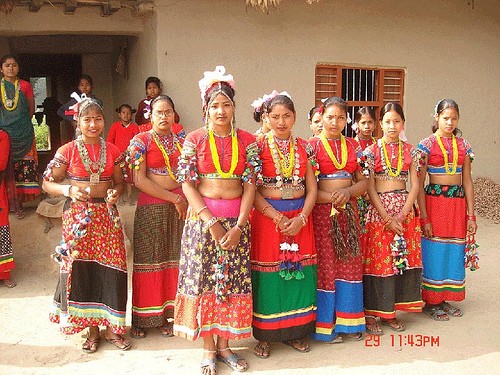
|
| |
|
|
JPEG

Please log in to subscribe to JPEG's postings.
Posted on 06-11-09 2:29
PM
Reply
[Subscribe]
|
Login in to Rate this Post:
0  ?
? 
|
| |
True_Beauty_of_Nepal drying her hair when she saw me clicking this!
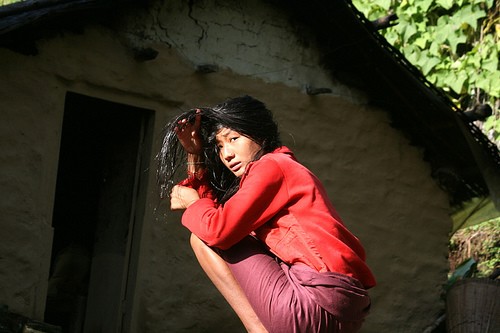
|
| |
|
|
JPEG

Please log in to subscribe to JPEG's postings.
Posted on 06-11-09 7:07
PM
Reply
[Subscribe]
|
Login in to Rate this Post:
0  ?
? 
|
| |
"Kalo chasma lau hai maiya bishal bazarko" She was camera shy so i insisted her wearing my kalo chasma. jpg
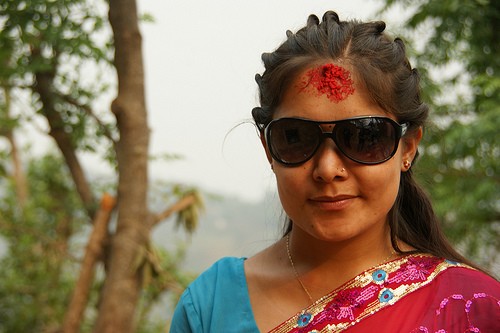
|
| |
|
|
JPEG

Please log in to subscribe to JPEG's postings.
Posted on 06-11-09 9:42
PM
Reply
[Subscribe]
|
Login in to Rate this Post:
0  ?
? 
|
| |
Not forgetting night time Sajhahites. "Chitko Sari makhmali choli lai beauty"
Last edited: 12-Jun-09 08:47 AM
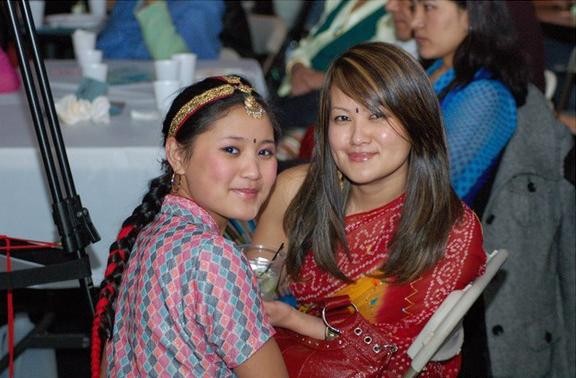
|
| |
|
|
JPEG

Please log in to subscribe to JPEG's postings.
Posted on 06-12-09 8:51
AM
Reply
[Subscribe]
|
Login in to Rate this Post:
0  ?
? 
|
| |
Sherpa ni beauty taking a rest while my way to Solu.
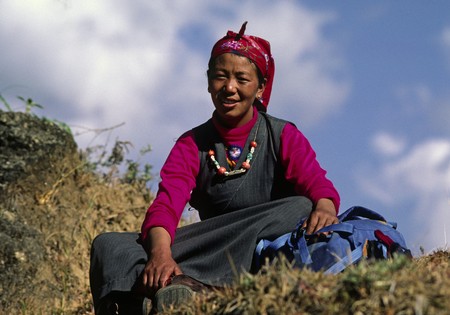
|
| |
|
|
JPEG

Please log in to subscribe to JPEG's postings.
Posted on 06-12-09 9:24
AM
Reply
[Subscribe]
|
Login in to Rate this Post:
0  ?
? 
|
| |
Tamang ni beauties in their beautiful costume. The Tamang (also known as Murmi) are one of the several ethnic groups living in Nepal descended from Tibeto-Burman origins. Living mainly north and east of the Newars in the Kathmandu Valley, they constitute 5.6% of Nepal's population, which places their population at 1,280,000, slightly higher than the Newars. Due to their geographical location, their language is vaguely intelligible with Nepal Bhasa but closely related to both Tibetan and Sherpa. The name Tamang, in Tibetan, means horse traders, which suggest that their ancestors came from the north and traded horses with the local community (Newars) and later settled and intermarried among them. However, many of them today earn a living through serving as porters. Like the Sherpas, they are also good mountaineers and mountain-guides. Some of Tamang are also recruited to serve in the British and Indian Gurkha regiments today. The Tamangs are followers of Tibetan Buddhism mixed with elements of the pre-Buddhist Bön and the Tambaist religion. Due to their proximity to the Newar, a slight Hindu influence can be seen in their practises. Their priests include Lama, Bombo and Tamba. According to the 2001 census, 90.26% of the ethnic Tamang in Nepal were Buddhists and 7.69% were Hindus. The typical song and dance of the Tamangs is "tamang selo" in which they dance to the beat of a drum called "damphu." Damphu is the traditional drum of the Tamangs. Many Tamang clans do not permit intermarriage with other ethnic groups, although some clans do permit intermarriages with the Gurung, Magar, Newar, Rai and Chhettri. Their descent is traced patrilineally.
Points to be taken: The Muluki Ain (National Code of Nepal) of 1854 set by the Rana rulers prevented Tamangs from joining British-India-Army and any government jobs in Nepal, except as Pipa (‘porter’) in Pipa Goswara office in Singha Durbar in Kathmandu. ~ Krishna B, Bhattachan, PhD The name Tamang, normally it is "Tamag" in Tibetan, means horse warriors, Tamags were border police sent by king Trisong of Tibet around 755. Kirat Itihas mention in "The History of the Kirat People" 2003, that the Tamang tribe of Nepal was brought to Kathmandu Valley by King Srong-sen Gampo of Tibet in the 7th century AD as a cavalry division. Their own tradition also says that their original habitat was in Southern Tibet in a place called Uichang. Tamang officers made Central Nepal their permanent settlement and settled around the Kathmandu valley and renamed villages after their names. Their villages were respectively called Moktan kipat, Bal kipat, Bomzan kipat, Ghising kipat, Pakhrin kipat, Yonzon kipat, Syangdan kipat, Thing kipat, Goley kipat, Giaba kipat, Mikchan kipat and Bozu kipat in the Chatara and Dhading districts. They ruled these villages till the Gurkha invasion in the west. Their kipat lands were annexed to the Gorkha Kingdom during the reign of King Prithvi Narayan Shah in 1768 AD.
Last edited: 12-Jun-09 09:47 AM
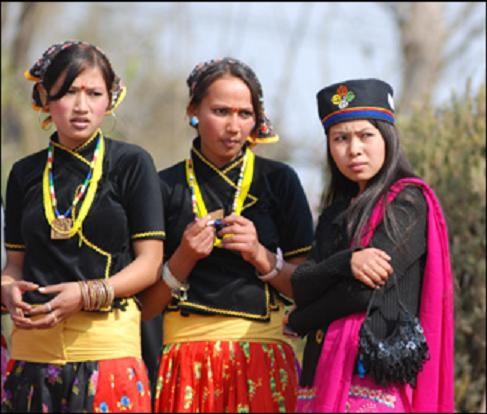
|
| |
|
|
JPEG

Please log in to subscribe to JPEG's postings.
Posted on 06-12-09 9:33
AM
Reply
[Subscribe]
|
Login in to Rate this Post:
0  ?
? 
|
| |
True_Beauty_of_Nepal_JPG is appreciated by 30 000 sajhaites already. This is what i have to say “Learn everything you can, anytime you can, from anyone you can - there will always come a time when you will be grateful you did.†For your viewing pleasure, behold the true beauty of Nepal
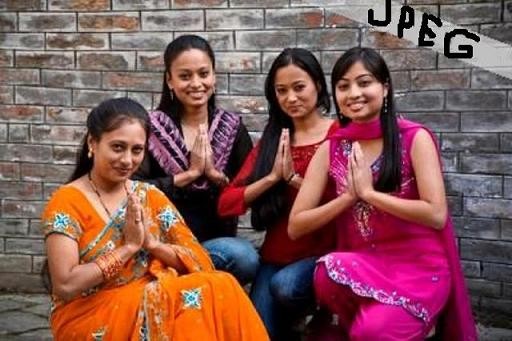
|
| |
|
|
JPEG

Please log in to subscribe to JPEG's postings.
Posted on 06-12-09 12:47
PM
Reply
[Subscribe]
|
Login in to Rate this Post:
0  ?
? 
|
| |
MaGu ni beauty. How you recognized Magar ni beauty from Gurung ni beauty? Answer: Look at the waist.  Gurung ni prefer blue patuki with their dress while Magar ni prefer yellow patuki.
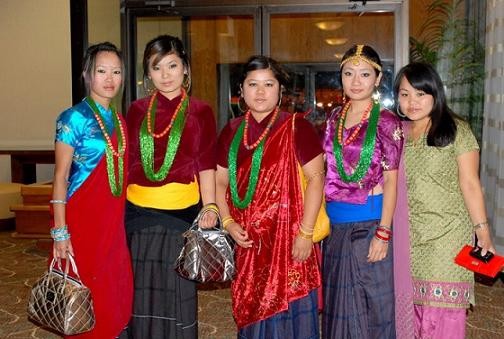
|
| |
|
|
JPEG

Please log in to subscribe to JPEG's postings.
Posted on 06-12-09 1:03
PM
Reply
[Subscribe]
|
Login in to Rate this Post:
0  ?
? 
|
| |
RaLi ni beauty. How you recognized Rai ni beauty from Limbu ni beauty? Answer: Look at the head.  Limbu ni wear the ornaments on top of their forehead while Rai ni prefer to wear it on their side.
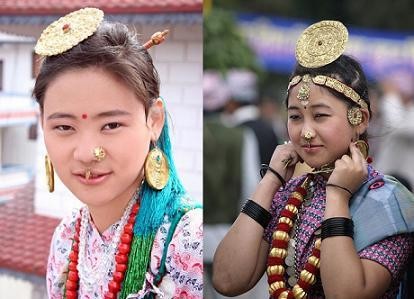
|
| |
|
|
JPEG

Please log in to subscribe to JPEG's postings.
Posted on 06-12-09 4:12
PM
Reply
[Subscribe]
|
Login in to Rate this Post:
0  ?
? 
|
| |
MaGuRaLi Beauties at this year Sakela Sili Ubhouli (Chandi) Festival in Aldershot, UK Origin of MaGuRaLi
The terminology 'Janajati' was heard in Nepal just before the 1990 people’ democratic movement, which ultimately established constitutional monarchy and multi-party democracy. The written form of the word, 'Janajati' had appeared in the book entitled Janajati Issues in Nepal by Sitaram Tamang published before the1990 movement. Before this book, there was another book called Unseen Realities in Nepali Politics in underground circulation. It was written by Gopal Gurung. In the later years of the Panchayat system, few politicians of Janajati origins started forming a secret group known as ‘Magurali’ denoting Magar, Gurung, Rai and Limbu, the four ethnic communities famous for being recruited in the British Gorkha army.~Nationalities, Movements and Nepali State by Keshab Man Shakya "The extensive Hindunisation of many Magar communities meant that activists had to try to recover, or perhaps rather devise 'authentic' customs and then cajole their fellow Magars into accepting them. They only made limited progress and at the end of the 1980s most Magars probably still accepted the claim to higher status of clans that used Brahmin priest that did not eat pork or buffalo. It could also be argued that, even were the activists to succeed in reversing this value system, they would still only be substituting for the old hierachy a new one dominated by the revalitlist writing Magar histories and publishing old Magar texts. The pace of ethnic and caste mobilization increased markedly during the 1980s, partly because of the loosening of restraints on political activity but also because the government had itself been trying to enlist both ethnic minorities and lower-caste groups in support of Panchayat system. As well as the establihment of new organizations and publications serving individual groups, there were efforts at colloboration. "Magurali' (standing for 'Magar-Gurung-Rai-Limbu'), an informal grouping of hill minorities, emerged even before the 1980 referendum. ~ A History of Nepal by John Whelpton
Points to be taken: The four group Magar, Gurung, Rai and Limbu were classified under Namasine(Unslavable) matawalis (liquor drinkers) in Muluki Ain (National Code of Nepal) of 1854 as qouted by J.B Rana "yo char matwali jaat sanga kharab na gara"! "The more prominent of the tribal groups such as the Magar, Gurung, Rai and the Limbu, who lived as agriculturists and soldiers in the army, were accorded the superior rank of the namasine matawali." by Prayag Raj Sharma (The State and Society in Nepal : Historical Foundations and Contemporary Trends) chpt9. Nepal: Hindu-Tribal Interface
Last edited: 12-Jun-09 04:15 PM

|
| |
|
|
JPEG

Please log in to subscribe to JPEG's postings.
Posted on 06-12-09 9:18
PM
Reply
[Subscribe]
|
Login in to Rate this Post:
0  ?
? 
|
| |
Two beauties of Nepal.
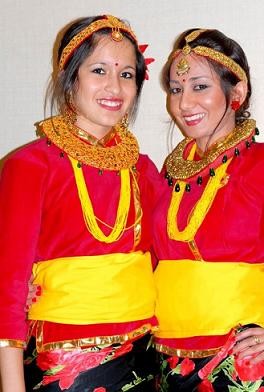
|
| |
|
|
JPEG

Please log in to subscribe to JPEG's postings.
Posted on 06-13-09 8:39
AM
Reply
[Subscribe]
|
Login in to Rate this Post:
0  ?
? 
|
| |
Beauty in the pink kurta surwal !

|
| |
|
|
JPEG

Please log in to subscribe to JPEG's postings.
Posted on 06-13-09 10:54
AM
Reply
[Subscribe]
|
Login in to Rate this Post:
0  ?
? 
|
| |
Rai ni beauties at Sakela Sili Ubhouli(Chandi) festival To begin what is Sakela? Sakela is the main festival of Kirat which is celebrated twice a year distinguished by two names Ubhauli and Udhauli. Sakela Ubhauli is celebrated during Baisakh Purnima (full moon day in the month of Baishak) and Sakela Udhauli is celebrated during the full moon day in the month of Mangshir. Udhauli puja is the worshiping of mother goddess. Udhauli means going down: It is believed that from this day the winter season starts. So people, birds and animal migrate from cold regions to warmer regions. This kind of migration occurs twice in a year. The celebration of migrating downwards during the season of Mangshir (Nov-Dec) is called "Udhauli (उधौली)" and the celebration of migrating upwards during the season of Baisakh (April-May) is called "Ubhauli (उभौली)". This has been going on since the dawn of the mankind when the Kirat people were hunters and gatherers which time is immemorial. The Vajasaneyi Samhita of the Shukla Yajurveda refers to the Kiratas as cave dwellers, hunters and gatherers. (Stone Age) Still today, animals and birds have seasonal migratory. Later when the Kirat people shifted from being hunters and gathers to agriculturalist and cultivation of crops(Neolithic Age), the festival became known as Bhumi Puja or land worshipping ceremony as Sakela falls on baisakh purnay (fifteenth day of the fifth month of Nepali calendar) coinciding with the sowing season. Kirat people are basically nature worshipers and during this festival prayers are offered to the natural supreme power Kirateswor (Lord of Kiratas), mother goddess, spirits, "nag-nagi" and nature asking for good crops and protection from natural calamities during the season of April (Ubhauli) where people starts to sow crops. Similarly, the celebration of Sakela Udhauli is the way of thanks giving to Goddess of nature for providing the good crops, as it is the time for harvesting before the cold seasons start to turn in.(Udhauli) This event of Kirati people has also been stated in Mundhum (holy book of Kirati people). The Sakela festival is celebrated with the Sili or ceremonial dances, which have their own significance and unique charm. Dances in different postures depicting the behavior of animals, birds, etc are performed to express gratitude to the creator. All Kirat group - Limbu, Rai, Yakkha and Sunuwar, celebrate this festival in different ways and have different names for it. Limbu call it "Chasok Tangnam", Rai call it "Sakela", Yakkha call it "Chasuwa" and Sunuwar called it "Syadar" . Still others called it Bhume, Bhunmidev, Chyabrung, Folsyandar, Saleladi, Sakewa, Sakenwa, Sakhewa, Sakel, Sime, Tosi, Tosh, Yokwa, etc depending on the sub-tribes of Kirat group and the distribution of Kirat people scattered across the Himalayan region from Himachal Pradesh, Nepal, Dareeeling, Assam and Sikkim. Some of the sub-tribe of Kirat group are Bangdel, Bahing, Bantawa, Chamling, Chepang, Dumi, Dhimal, Hayu, Jirel, Jerung, Lohorung, Khaling, Khulung,Koch, Makurang, Mewahang, Naachhiring, Puma, Praya, Rakhali, Sampang, Sotang, Surel, Tamla, Tilung, Thulung, Thami, Wambule, Yaamphu, Yellung, etc.....! Hence the sakela is not only the festival of the Kirat people but also of all the people living in hilly regions and to those who worship Mother Nature in their day to day life. The festival starts with Shakti Puja performed by the nakchhong (kirati priest). The Rais also observe Sakewa in their homes. Three lungs (stones) are installed in the prayer room to make a furnace called Samkha. The lungs have unique names: Suptulung, Taralung and Shakhalung. While invoking the blessings of the goddess, a fire is lighted in the furnace and the names of the forefathers are called out aloud while offering food, millet drink(tongba), ginger and water. The pot used for the water is called Wabuk or Salawadar) coinciding with the sowing season.
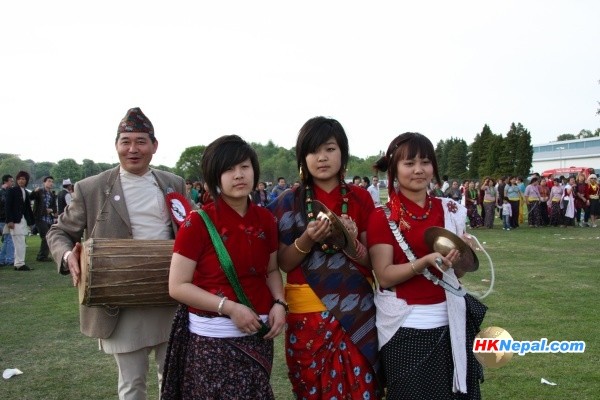
|
| |
|
|
JPEG

Please log in to subscribe to JPEG's postings.
Posted on 06-13-09 2:53
PM
Reply
[Subscribe]
|
Login in to Rate this Post:
0  ?
? 
|
| |
More beauties for your viewing pleasure. What is Chandi? The celebration of Sakela is connected to many myths. One of them being dedicated to mother Goddess Kiratini who is better known by Chandika and Durga. Hence the Sakela festival is also know as Chandi naanch. Chandi naanch is the worshiping and giving thanks to mother Goddess Chandika(Durga) to help the people get rid of evil demon Mahishasura. Kali Prasad Goswami in his book Kamakhya Temple mentions more about the Durga caste and the Durga puja. Here's a short except of work from this book: "Swami Prajnananda says Savarotsava is Durga Puja. Swami Abhedananda remarks that Durga was worshiped by Savar, Barbar, Pulinda caste. She was addicted to meat and wine, etc. The Chandipuza of autumn season was therefore called Savarotsava.............Durga and Chandi were the goddess of the Kirata caste. So Durga other name is Kiratini". ~ Kamakhya Temple By Kali Prasad Goswami According to Coburn, it is striking that the word Candika has virtually no earlier history in Sanskrit. "There are no instances of its occurrence in the Vedic literature we have surveyed. The epics are similarly barren: neither the Ramayana nor the Mahabharata give evidence of the epithet, although in one of the hymns inserted in the latter Canda and Candi are applied to the deity they praised". ~ Devi Mahatmya by Coburn, Thomas B. The Sanskrit dictionary, (Monier-Williams) explains Matamgi as names of the mythical mother of elephant tribe; a Candala or Kirata woman; name of a form of Durga, and further as one of the ten mahavidyas and as the mother of Vasistha. Matamga means elephant, Candala (man of the lowest rank) or Kirata(mountainer, babarian), and the name of the serpent demon. ~ Nityasumagali By Saskia C. Kersenboom-Story, Saskia Kersenboom Points to be taken. This festival, once banned by one of the Malla kings, was again officially recognized by the government as the Kirat’s festival in 2058. It is gaining popularity among young generation.
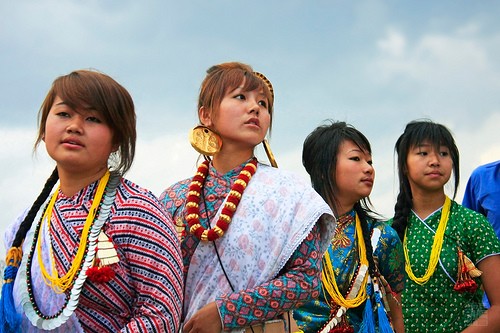
|
| |
|
|
JPEG

Please log in to subscribe to JPEG's postings.
Posted on 06-14-09 9:27
AM
Reply
[Subscribe]
|
Login in to Rate this Post:
0  ?
? 
|
| |
Beautiful Nepali girls i saw riding a bicycle in Bhairawa approaching my direction.
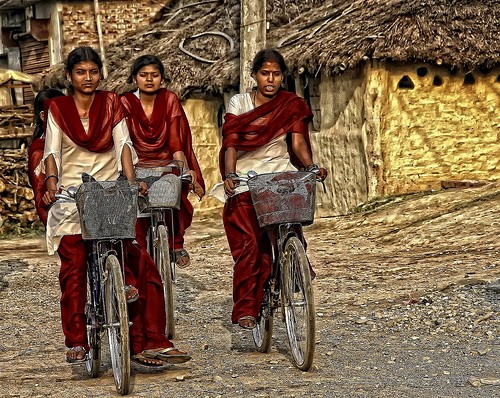
|
| |
Please Log in! to be able to reply! If you don't have a login, please register here.
YOU CAN ALSO

IN ORDER TO POST!
Within last 90 days
| Recommended Popular Threads |
Controvertial Threads |
| TPS Re-registration |
| What are your first memories of when Nepal Television Began? |
| निगुरो थाहा छ ?? |
| Basnet or Basnyat ?? |
| TPS Re-registration case still pending .. |
| Sajha has turned into MAGATs nest |
| NRN card pros and cons? |
| Will MAGA really start shooting people? |
| मन भित्र को पत्रै पत्र! |
| Top 10 Anti-vaxxers Who Got Owned by COVID |
| काेराेना सङ्क्रमणबाट बच्न Immunity बढाउन के के खाने ?How to increase immunity against COVID - 19? |
| TPS Work Permit/How long your took? |
| Breathe in. Breathe out. |
| 3 most corrupt politicians in the world |
| Guess how many vaccines a one year old baby is given |
| अमेरिकामा बस्ने प्राय जस्तो नेपालीहरु सबै मध्यम बर्गीय अथवा माथि (higher than middle class) |
| चितवनको होस्टलमा १३ वर्षीया शालिन पोखरेल झुण्डिएको अवस्था - बलात्कार पछि हत्याको शंका - होस्टेलहरु असुरक्षित |
| शीर्षक जे पनि हुन सक्छ। |
| Disinformation for profit - scammers cash in on conspiracy theories |
| someone please tell me TPS is here to stay :( |
|
| Nas and The Bokas: Coming to a Night Club near you |
|
NOTE: The opinions
here represent the opinions of the individual posters, and not of Sajha.com.
It is not possible for sajha.com to monitor all the postings, since sajha.com merely seeks to provide a cyber location for discussing ideas and concerns related to Nepal and the Nepalis. Please send an email to admin@sajha.com using a valid email address
if you want any posting to be considered for deletion. Your request will be
handled on a one to one basis. Sajha.com is a service please don't abuse it.
- Thanks.
|
